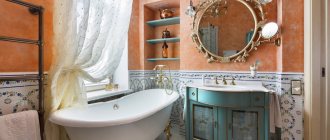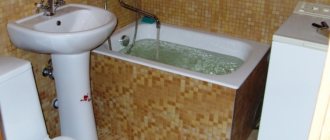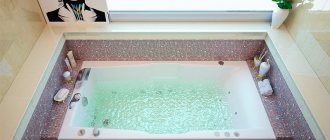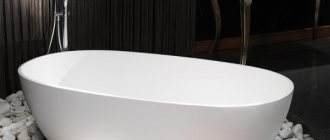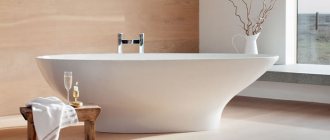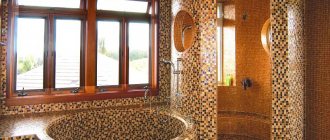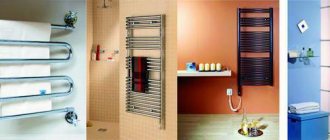Cast iron is the very first material from which bathtubs were made on an industrial scale.
Until now, they are popular among consumers due to their undeniable advantages .
What is the first association that comes to mind when you hear “cast iron bathtub”? That's right, it's very heavy. Heavy weight is a distinctive feature of products made from this material.
If you are planning to choose and buy a cast iron hot tub or, perhaps, on the contrary, get rid of it, would it be a good idea to know how much it weighs? We will talk about this in detail in the article.
Advantages and disadvantages of a cast iron bathtub
Plumbing manufacturers use new materials - acrylic, earthenware, marble, but cast iron continues to be in great demand; it is the leader in the plumbing market. Such baths, despite their conservative design, have many advantages.
Among them:
- Long service life. Cast iron products are 3-5 times superior to competitors in this parameter. Many apartments still have old bowls from Soviet times in good condition. Manufacturers claim a service life of 30 years, but according to statistics, such things last longer. There are restoration systems for cast iron bowls that extend their service life.
- Temperature preservation. Having heated up once, the bowl gives off heat for a long time, the water slowly cools down. In addition, this allows you to save resources.
- Strength. Cast iron is a hard metal, products made from it will not bend or change shape. Under the weight of water and the human body, the bathtub will not sag or deform when a heavy object falls into it.
- Stability and reliability. The bathtub is heavy, so it is difficult to tip it over when sitting on the side, or to move it from its place. The set includes supports that can withstand the entire weight. This provides additional safety - the bathtub stands firmly on the supports, and due to its large mass it is securely fixed to them.
- Noise insulation. The cast iron walls are thick - 5-7 mm, due to this the sound of water falling from the tap is absorbed.
- Anti-corrosion coating. The original appearance is preserved for a long time, and the enamel that covers the surface lies evenly and smoothly, which gives shine and gloss. It is applied in several layers, so you can wash your pets in the bath - claws will not harm the coating.
- Easy to care for. The smooth enamel surface does not retain dirt, so it is easy to care for. You can clean it with household chemicals that do not contain acid or large abrasive particles.
- There are models on the market with additional useful options - hydromassage, comfortable handles, anti-slip coating.
Disadvantages of cast iron models:
- Difficulty in transportation and installation. The bowls weigh at least 90 kilograms, so the help of loaders will be required.
- Warm-up required. You should pour water hotter than required for swimming, because part of the heat will be used to warm up the thick walls.
- High price. A product made of cast iron has a higher price than analogues made of acrylic, earthenware and other materials, but has a longer service life.
- Limited forms. The complexity of cast iron does not allow us to produce bowls of complex shapes, so the range is limited.
Results
If you intend to purchase a cast iron bathtub, you should first find out what the weight of the cast iron bathtub is. This parameter must be taken into account when installing equipment in multi-story buildings. If heavy plumbing does not create a special load on concrete floors, then with wooden beams the situation is different.
The modern market offers a huge selection of cast iron plumbing fixtures, so you can purchase a model of the appropriate size, shape and color. Despite the fact that significant weight is a disadvantage of the devices, they are practically indestructible. Therefore, a cast iron hot tub will serve you for many years.
Weight of Soviet baths
Cast iron bowls in the Soviet Union were made in several sizes; GOST established three main standard models:
- HF - enameled cast iron;
- VChM - modernized version;
- HFMO - modernized lightweight.
The material for cast iron bathtubs contains more carbon than steel, so the products are more fragile. Manufacturers are forced to make thick walls to support the load, which increases the final weight.
Length 150 cm
A common model in the USSR was a rectangular container 150x70 cm. The weight of such a product ranged from 98 (modernized version) to 102 kg (simple enameled). More comfortable options had a larger width, from 75 to 85 cm, weighing from 110 to 130 kg. The depth of all products is standard.
Length 170 cm
A longer bathtub weighed more, up to 110 kg with the same width of 70 cm. This model is more difficult to transport. The weight of wider baths was 120-145 kg.
Soviet cast iron bath.
Peculiarities
Soviet products, in addition to dimensions, have additional features. In particular the coating. After all, the quality of enamel affects the duration of operation and appearance during this period. The standard thickness of the enamel coating is one millimeter. In addition, the inside of the product is absolutely smooth, without cracks or chips.
The reliable design has the correct geometric shape. There are also no uneven edges, corners or folds. Safe operation is ensured by installing special armrests and handles. In addition, additional treatment of the bathroom with a special solution prevents corrosion.
The choice of colors is quite modest. Only now have technologies emerged that make it possible to bring any idea to life. During the Soviet period, the white model was the most common option.
Weight of modern cast iron baths
Modern production has made the products lighter; now they weigh less than their Soviet counterparts. Technologies have made it possible to maintain strength while reducing wall thickness. Modern cast iron bathtubs are not subject to old standards, and GOST standards do not impose strict weight requirements. According to current standards, the minimum thickness of the bowl and the enamel coating layer is not regulated.
Russian 150 cm long
A modern bowl of standard dimensions 150x70 cm weighs about 90 kg. This option is well suited for installation in Soviet-era apartments where bathroom space is limited. The difference in weight with Soviet models is about 10 kg.
Length 170-180 cm
Thinner walls affected the final weight, which became 12-20 kg less than older models. The weight of modern cast iron bathtubs is in the range of 99-108 kg.
Length less than 150 cm, sessile
Cast iron models with a length of less than 150 cm are called “sedentary”; the width of such models is standard - 70 cm. It will be uncomfortable for a person of average height to take a bath, but such products are well suited for small bathrooms. The approximate weight of seated models is about 80 kg, foreign models are 8-12 kg less.
USSR sitz bath.
Modifications
There are several main modifications of Soviet fonts. For example, corner structures are produced only at large enterprises. After all, production requires additional capacity.
Oval fonts are most often made on special legs. Such models are not adjacent to the wall.
The standard option is a rectangular bathroom with typical dimensions. It has rounded corners inside the bowl and high stability.
Comparison of weight of models from different manufacturers
An analysis of products from domestic and foreign manufacturers showed that imported sanitary ware is 15-30 kg lighter with equal length and width. This is due to the fact that many countries save water, so the depth of imported bowls does not exceed 35 cm. For Russian models, this figure is greater - 45-60 cm.
Chinese and European models are produced with thinner walls; instead of 8-10 mm, they are made of 5 mm. There are thinner options, which affects the characteristics of the entire product and reduces its service life. Chinese manufacturers skimp on the enamel layer, and this negatively affects the quality of the coating and resistance to mechanical damage. Such methods make it possible to reduce the final weight of the product, but other characteristics deteriorate.
The weight of a 170x70 cm Italian bathtub is 78 kg. Among European manufacturers of plumbing fixtures, Castalia stands out; it produces a 170x70 cm model that weighs 120 kg, which is heavier than similar domestic products.
Installation
Installation should begin with placing the bathtub indoors. It must be turned over in advance in order to secure the leg parts. To do this you will need brackets and a set of tools. Next, install the siphon and drainage system. In this case, the structure must be located at a certain angle to the drain hole. You can adjust its position using the support part and the building level.
The contact points between the structure and the wall should be treated with a special protective compound. This must be done to ensure the tightness of the joints. Do not forget about installing a water shutter mechanism. After which you can begin to secure the outlet pipe.
In addition, grounding must be provided. After all, cast iron is a conductor of electricity. Before starting use, it is better to fill the bathtub with several liters of cold water. Only after this can you fully enjoy water procedures.
Steel bath weight
Metal baths are often also called iron baths. Steel and cast iron are alloys of iron and carbon; the materials differ in the percentage of these components, which determines the difference in properties.
Steel bath 180×80.
Steel baths are about 5 times lighter than cast iron, although steel is a heavier material. Due to the greater strength of the wall, steel products do not need to be made thick - the standard size is 2-3 mm. If they are thinner, there is a possibility of their deformation under load.
Weight depends on the configuration and dimensions of the bowl. The seated model 90x60 cm weighs up to 15 kg, the standard 150x70 - about 20 kg. The long version from 170 cm weighs more than 30 kg. If a steel bowl weighs too little, this is an indicator of poor quality material. Such products will not withstand long-term use; they will give off heat too quickly and become deformed.
How much does cast iron weigh or why is it so heavy?
A cast iron bathtub has been deservedly used for decades. Back in Soviet times, its use proved the reliability and durability of cast iron.
One of the disadvantages of such baths is their heavy weight. Cast iron is not a light alloy. Its density averages 7200 kg/m3. Compared to steel, this alloy contains more carbon, which makes it brittle.
Therefore, in order for the bathroom to be truly resistant to deformation, it is made with thick walls. The wall thickness of bathtubs from domestic manufacturers is 7-10 mm. This is what causes their heavy weight (from 80 kg).
This will probably seem untrue or incredible to you, but cast iron is lighter than steel. Steel has a higher density compared to cast iron - on average 7800 kg/m3.
Why are steel bathtubs lighter than cast iron bathtubs?
The wall thickness of steel bathtubs is half as thin (3-4 mm) as that of cast iron bathtubs - as a result, the total weight of the product is less.
Are you planning to change your bathtub and can’t choose a model? Our review contains sizes, prices and photos of cast iron bathtubs of both Russian and foreign production.
Our article will tell you what glass bath curtains are.
Modern bathtubs that combine all the advantages of a bathtub and a shower. Do you think such things exist? Yes, and examples in our article.
Conclusion
Now you know what the weight of a steel bathtub should be, 150cm or 170cm, it doesn’t matter. You are also “armed” with a certain set of advantages and disadvantages that will allow you not to get confused when choosing and purchasing a steel bathtub. Well, you can always modify the product yourself, spending a minimum amount of money.
- Author: Vasily
Rate this article:
- 5
- 4
- 3
- 2
- 1
(0 votes, average: 0 out of 5)
Share with your friends!
What materials are they made from?
All bathtub models produced today are made from the following materials
:
| Material | Weight | Advantages | Flaws | Average price size 170×75 |
| Acrylic (plastic) | the weight of the 170 cm acrylic model is 13–25 kg | – light weight; – wide choice of models and configurations; – does not turn yellow or darken; – absorbs sound well; – holds heat well; – acrylic is not liked by germs and bacteria; – easy to clean with a soft sponge | – subject to mechanical deformation, easily broken by a dropped bottle of shampoo; – short-lived (service life 10–15 years); - high price; – Do not pour undiluted hot water into it | 9 -150 thousand grew. rub. |
| Steel | how much does a steel model 150x70 weigh - approximately 30–40 kg | – wide range of models and configurations; – long service life (35–40 years); – has no pores where microbes grow | – the water cools quickly; – the bowl bends and becomes deformed; – a jet of water when hitting the bottom creates a lot of noise; – if there is a washing machine nearby, without grounding there is a risk of getting an electric shock | 8–30 thousand grew. rub. |
| Quaril (compound of acrylic and quartz) | 45–50 kg | – has a dazzling shine and perfect whiteness; – durable and strong; – absorbs sound well; – non-slip surface; – the water cools slowly; – anti-slip coating; – not subject to mechanical deformation | – is very expensive; – small selection of shapes and configurations; – it is difficult to choose a toilet and pieces of furniture that are similar in appearance; – you can’t pour hot water | 42–142 thousand grew. rub. |
| Fake diamond | – smooth and even coating; – not demanding on cleaning products; – antiseptic properties; – not afraid of impacts and chips; – muffles sounds; – maintains optimal temperature | - high price; – absorbs paint; – cannot be cleaned with powders; – difficult to choose accessories; – expensive repairs in case of damage | From 25 thousand grew. rub. |

